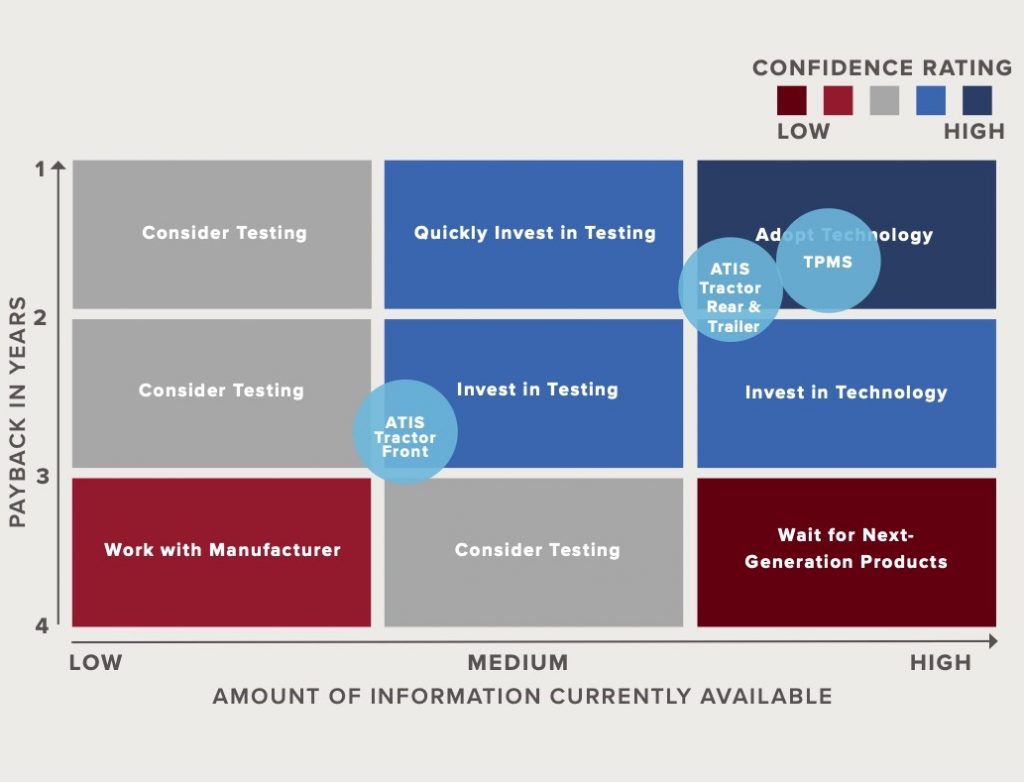Tire Pressure Monitoring
Proper tire inflation pressure is critical to the proper operation of a commercial vehicle. Correct tire inflation reduces tire wear, increases fuel efficiency, and leads to fewer roadside breakdowns due to tire failures.

However, studies show that:
- About one in five trailers is operating with one or more tires underinflated by at least 20 psi.
- Nearly 3.5% of all tractors/trucks operate with four or more tires underinflated by at least 20 psi.
- 3% of all trailers operate with four or more tires underinflated by at least 20 psi.
- Approximately 3% of all trailers, and more than 3% of all tractors/trucks, are operating with at least one tire underinflated by 50 psi or more.
- Only 46% of all tractor tires and 38% of all trailer tires inspected were within +/- 5 psi of the target pressure.
Tire pressure monitoring systems (TMPS) monitor pressure and, in some cases, temperature, for each individual tire using various sensor locations and warning methods. In most cases the system will transmit the data and display it to the operator and/or fleet. The TPMS monitors each tire based on a pre-set target pressure, and issues alerts based on the difference between the target pressure and the actual measured pressure in the tire.
Approximately 25% to 30% of tractors and 15% of trailers are equipped with tire pressure monitoring systems.
Benefits
Fuel Savings
The system keeps tires properly inflated, which reduces rolling resistance and improves fuel economy.
Underinflation Warning for Drivers
Drivers get real-time notification of pressure loss, allowing them to add air to the tires before damage occurs.
Reporting on Tire Condition
The sensors tell the exact temperature and inflation pressure of the tire so drivers will know how serious the condition is.
Tire Pressure Reporting by Wheel Position
Drivers know exactly which tire is underinflated and don’t have to walk around the truck trying to figure out where the problem tire is.
Enables Remote Monitoring
Tire condition can be monitored remotely via telematics.
Challenges
No Inflation Capability
Tire pressure monitoring systems do not inflate an underinflated tire. They only inform the driver of underinflation.
Possible False Positives
The system may report false positives of underinflation.
Stops Required
Because the system does not correct underinflation, the driver must stop the vehicle to correct the underinflation.
Fleet Perspectives
Fleets are realizing that their current tire pressure maintenance practices, which typically consist of having drivers manually check tire pressure, are not sufficient to keep the tires inflated to their proper levels.
Most fleets interviewed recognize the benefits of proper tire pressure and are considering the adoption of technologies that better ensure that tractor and trailer tires are properly inflated.
Fleets also shared that that tire pressure monitoring systems can offer enough value that they would consider retrofitting them on tractors and trailers which had enough life left in them to justify the expense.
Early adopters of tire pressure monitoring systems include tankers, vehicles with high trailer miles and/or low trailer-to-tractor ratios and vehicles with duty cycles that have diminishing loads.
Decision-Making Tools
The NACFE team developed a decision making tool to help fleets make decisions about purchasing TPMS. The Confidence Matrix summarizes the study findings and indicates NACFE’s confidence in the various tire pressure monitoring systems.

Conclusions
The currently available commercial vehicle tire pressure monitoring systems are reliable and durable. There are strong options for various truck duty cycles and fleet business models.
Manufacturers continue to develop system for improved performance, better reliability and lower overall costs. As systems become more available from the tractor and trailer manufacturers, the quality of the installation increases and costs decrease. This should lead to increased adoption of tire pressure monitoring systems.
Factors contributing to satisfactory operation of a tire pressure monitoring system include:
- Matching the fleet’s need with the specific capabilities of the various tires pressure monitoring systems currently available;
- Training personnel and developing internal operating procedures around the new tire pressure monitoring system;
- Seamless integration of the TPMS into the fleet’s day-to-day operation.